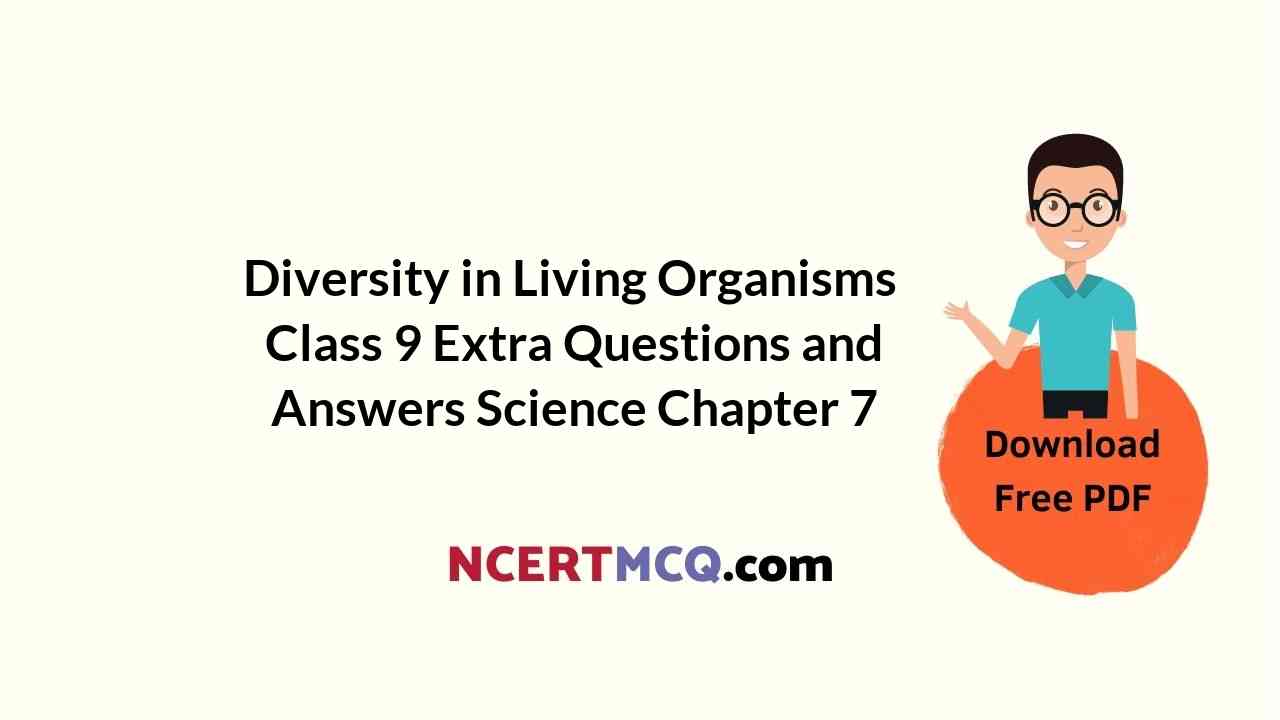In this page, we are providing Diversity in Living Organisms Class 9 Extra Questions and Answers Science Chapter 7 pdf download. NCERT Extra Questions for Class 9 Science Chapter 7 Diversity in Living Organisms with Answers will help to score more marks in your CBSE Board Exams. https://ncertmcq.com/extra-questions-for-class-9-science/
Class 9 Science Chapter 7 Extra Questions and Answers Diversity in Living Organisms
Extra Questions for Class 9 Science Chapter 7 Diversity in Living Organisms with Answers Solutions
Diversity in Living Organisms Class 9 Extra Questions Very Short Answer Type
Class 9 Science Chapter 7 Extra Question Answer Question 1.
Who proposed the two kingdom classification?
Answer:
Carolus Linnaeus.
Diversity In Living Organisms Class 9 Extra Questions And Answers Question 2.
What is biodiversity?
Answer:
The variety of life forms including plants, animals and microscopic organisms which inhabit this earth constitute biodiversity.
Diversity In Living Organisms Class 9 Questions Question 3.
What is classification?
Answer:
The grouping of organisms on the basis of their similarities and differences is called classification.
Diversity In Living Organisms Class 9 Extra Questions Question 4.
What is the taxonomy?
Answer:
The branch of science which deals with the classification of organisms is called taxonomy.
Diversity In Living Organisms Extra Questions Question 5.
Who proposed the five kingdom system of classification?
Answer:
R.H. Whittaker.
Diversity In Living Organisms Class 9 Questions And Answers Question 6.
Name the fundamental unit of classification.
Or
Which is the lowermost category in the hierarchy of classification?
Answer:
Species.
Diversity In Living Organisms Class 9 Extra Questions And Answers Pdf Question 7.
Give one point of difference between gymnosperms and angiosperms.
Answer:
The seeds of gymnosperms are naked whereas the seeds of angiosperms are enclosed within a fruit.
Diversity In Living Organisms Class 9 Important Questions Question 8.
Name the largest phylum of kingdom Animalia.
Answer:
Arthropoda.
Class 9 Science Ch 7 Extra Questions Question 9.
Name the class to which the sea horse belongs.
Answer:
Sea horse belongs to class Pisces.
Questions On Diversity In Living Organisms Class 9 Question 10.
Which group of plants is referred to as vascular cryptogams?
Answer:
Pteridophytes.
Class 9 Diversity In Living Organisms Extra Questions Question 11.
Which phylum in animial kingdom consists of pseudocoelomate organisms?
Answer:
Nematoda
Class 9 Science Chapter 7 Extra Questions Answers Question 12.
Which group of organisms are called as the ‘Amphibians of plant kingdom*?
Answer:
Bryophytes
Diversity In Living Organisms Class 9 Fill In The Blanks Question 13.
Name the two classes of angiosperms with one example of each.
Answer:
The two classes are –
- Monocots: Wheat
- Dicots: Pea
Diversity In Living Organisms Important Questions Question 14.
Name the division of cryptogams to which algae belong.
Answer:
Thallophyta
Class 9 Diversity In Living Organisms Questions Question 15.
Which is the highest unit of classification?
Answer:
Kingdom
Question 16.
What is the characteristic feature due to which echinoderms are named?
Answer:
Spiny skin (Echino- spiny; derm-skin)
Question 17.
Name the group which comprises of bacteria and blue green algae.
Answer:
Monera
Question 18.
Name an organism which is called saprophyte. Why is it called so?
Answer:
Yeast. It is called so as it feeds on dead and decaying matter to obtain its nutrition.
Question 19.
Identify the kingdom in which the organisms do not have a well-defined nucleus and are not able to show multicellular designs.
Answer:
Monera
Question 20.
Give reason, why blue green algae are classified along with bacteria and placed in the kingdom Monera.
Answer:
As the blue green algae are unicellular prokaryotes like bacteria.
Question 21.
Mention any one characteristic feature of saprophytes.
Answer:
The saprophytes feed on dead and decaying organic matter.
Question 22.
Write one point of difference between monocotyledonous and dicotyledonous plants.
Answer:
Monocots are plants which bear single cotyledon in their seeds. Dicots are the plants which bear two cotyledons in their seeds.
Question 23.
Poriferans have hole or pores all over the body that lead to a system that helps in circulating water to bring in food and oxygen. Name the system.
Answer:
The system is called as the canal system.
Question 24.
State the phylum to which liver fluke and Planaria belong.
Answer:
Phylum Platyhelminthes
Question 25.
Write the type of body cavity and symmetry possessed by nematodes.
Answer:
Body cavity is pseudocoelom and symmetry is bilateral symmetry.
Question 26.
Name one mammal that lays eggs.
Answer:
Platypus
Question 27.
Name the substance which Coelomic cavity of arthropods is filled with. What type of symmetry do they have?
Answer:
Coelomic cavity of arthropods is filled with blood. They show bilateral symmetry.
Question 28.
Name the phylum to which centipede and prawn belong.
Answer:
Phylum Arthropoda
Question 29.
Echinoderms are marine animals. What is their skeleton made up of?
Answer:
Their skeleton is made up of calcium carbonate.
Question 30.
Name one reptile with a four chambered heart.
Answer:
Crocodile
Question 31.
Shyam knew the correct scientific name of mango but did not follow the convention while writing it and wrote it as Mangifera Indica. Rewrite the scientific name as per the convention.
Answer:
Mangifera indica
Question 32.
Rewrite the scientific names correctly:
(a) Panthera tigris
(b) Periplaneta Americana
Answer:
(a) Panthera tigris
(b) Periplaneta americana
Diversity in Living Organisms Class 9 Extra Questions Short Answer Type 1
Question 1.
How can we say that classification of organisms is closely related to their evolution?
Answer:
We can say that classification of organisms is closely related to their evolution because the simple organisms have a primitive body design as they appeared earlier whereas the complex organisms have more advanced body designs as they are more recent. This shows that during the course of evolution more complex body designs were formed from simpler ones.
Question 2.
What is the difference between algae and fungi?
Answer:
Algae:
- Have chlorophyll.
- Autotrophic mode of nutrition.
- Cell wall made of cellulose.
- Food stored in the form of starch.
- Examples: Chlamydomonas, Spirogyra, Ulo-thrix
Fungi:
- Lack chlorophyll.
- Heterotrophic mode of nutrition.
- Cell wall made of chitin.
- Food stored in the form of glycogen.
- Examples: Rhizopus, Agaricus, Yeast
Question 3.
Pick the odd one out and justify your choice by giving reasons:
(a) Moss, Fern, Pinus, Spirogyra
(b) Sea cucumber, Octopus, Feather star, Star fish
Answer:
(a) The odd one out in this case is Pinus as it is a phanerogams having covered reproductive parts whereas the other three are cryptogams which bear hidden reproductive organs.
(b) The odd one out in this case is Octopus as it belongs to phylum Mollusca while others are the members of phylum Echinodermata.
Question 4.
Why were fungi and bacteria considered as plants even though they do not have chlorophyll?
Answer:
Fungi and bacteria were considered as plants as they have cell wall which is a characteristic feature of the plants. So, some earlier classification systems included them under plants.
Question 5.
Why do bryophytes and pteridophytes grow in moist and shady places?
Answer:
Bryophytes and pteridophytes grow in moist and shady places as they need water for their reproduction. Male gametes are carried towards the female gamete by water in order to bring about fertilisation in them.
Question 6.
Which divisions of the plant kingdom are called cryptogams? Why are they called so?
Answer:
Thallophyta, Bryophyla and Pteridophyta are considered as cryptogams. They are called so because they bear hidden and inconspicuous reproductive orgAnswer:
Question 7.
Characteristics of some organisms are given. Identify their group and give one example of each.
(а) Single celled, eukaryotic and photosynthetic
(b) The body is divided into segments, may be unisexual or hermaphrodite
Answer:
(a) Protista: Euglena
(b) Annelida: Earthworm
Question 8.
How do saprophytes get their food? Give one example of saprophyte.
Answer:
Saprophytes derive their nutrition from the dead and decaying materials. For example, Agaricus (Mushroom), Rhizopus (Bread mould), Yeast etc.
Question 9.
What are phanerogams? How are they classified?
Answer:
The phanerogams are the plants which produce seeds and have a well differentiated body with true roots, stem and leaves. They are advanced members of kingdom Plantae. It includes gymnosperms and angiosperms.
Question 10.
What are gymnosperms? Give two examples.
Answer:
The plants which bear naked seeds which are not enclosed in fruit are called gymnosperms. For example, Cycas, Pinus, etc.
Question 11.
Write two peculiar characters of sponges.
Answer:
The two peculiar features of sponges are:
(i) They have pores called ostia all over their body and a single large opening at the top, called osculum which helps to develop a canal system for water movement.
(ii) They have a skeleton made up of calcareous or siliceous spicules or spongin fibres which gives strength and support.
Question 12.
Classify the following in their respective phylum/class: Jellyfish, earthworm, cockroach, rat
Answer:
- Jellyfish: Phylum Coelenterata
- Earthworm: Phylum Annelida
- Cockroach: Phylum Arthropoda
- Rat: Phylum Vertebrata, Class: Mammalia
Question 13.
What are the two peculiar features of phylum Echinodermata?
Answer:
The phylum Echinodermata has organisms which have
- spiny skin
- water vascular system
Question 14.
What are the three germ layers present in the organisms? What are the two groups of organisms on the basis of germ layers?
Answer:
The three germ layers are ectoderm, mesoderm and endoderm. The groups are diploblastic and triploblastic.
Question 15.
How are vertebrates different from the other chordates?
Answer:
The notochord is present at any stage of their life cycle in the case of chordates. In the vertebrates the notochord gets replaced by the vertebral column.
Question 16.
How are pteridophytes are different form Phanerogams? Give one example for each group.
Answer:
Pteridophytes have hidden, inconspicuous reproductive organs example ferns.
Phanerogams have well differentiated reproductive organs which are not hidden, example rose, apple.
Question 17.
(a) Given below are few plant species. Identify the divisions to which they belong and write the major characteristic of each division.
(i) Spirogyra
(ii) Deodar
(iii) Moss
(b) What is the mode of nutrition for all of them?
Answer:
(a) (i) Thallophyta: Plant body is not well differentiated
(ii) Gymnosperms: have naked seeds
(iii) Bryophyta: have rhizoids for absorption of water, have stem-like and leaf-like structures.
(b) All of them are autotrophic organisms.
Question 18.
What do you understand by the term ‘naked embryo’? Name any two divisions in kingdom Plantae that have naked embryo. Give one example of each division.
Answer:
Naked embryo is the term which refers to an embryo which is not borne inside the seed. The pteridophytes and gymnosperms bear naked embryo. For example, Ferns and horsetail are pteridophytes. Pinus and Cycas are gymnosperms.
Question 19.
Write the difference between Gymnosperms and Angiosperms giving example of each type.
Or
What are gymnosperms? Give two characteristics.
Answer:
Gymnosperm:
- Bear naked seeds.
- Are woody, evergreen, perennials.
- Examples: Pinus and Cycas
Angiosperm:
- Bear seeds enclosed in fruit.
- Can be woody, non-woody annual, biennial or perennials.
- Examples: Mango, Neem
Question 20.
Thallophyta, bryophyta and pteridophyta are classified as cryptogams whereas gymnosperms and angiosperms are classified as phanerogams, why?
Answer:
Due to the presence of hidden and inconspicuous reproductive organs, thallophyta, bryophyta and pteridophyta are called as cryptogams. Gymnosperms and angiosperms are phanerogams as they have well developed and distinct reproductive organs, flowers, fruits and seeds.
Question 21.
State reasons for the following:
(а) Platyhelminthes are called so.
(b) Birds have hollow bones.
Answer:
(a) Platyhelminthes are called so because they have a dorsoventrally flattened body.
(b) Presence of hollow bones is an adaptation in birds which helps them to keep low body weight which is helpful in flight.
Question 22.
Identify the phylum of animals by the given characteristics and give an example of each.
(a) The coelomic cavity is blood-filled and the animals have jointed legs.
(b) The animals are called as flatworms and are either free living or parasitic.
Answer:
(a) Phylum arthropoda: eg., cockroach, butterfly, spider, etc.
(b) Phylum Platyhelminthes: Planaria, liver fluke, tapeworm, etc.
Question 23.
Write one point of difference between the following:
(а) Bilateral symmetry and radial symmetry
(b) Annelids and Nematodes
Answer:
(a) Bilateral symmetry – Body can be divided into two exact halves from one plane only.
Radial symmetry – Body can be divided into equal halves from any plane.
(b) Annelids – Have true coelom
Nematodes – Have pseudocoelom.
Question 24.
Give two examples of each:
(а) Egg laying mammals
(b) Organisms with open circulatory system.
Answer:
(а) Duck-billed platypus and Echidna are the egg laying mammals.
(b) Cockroach and Octopus have open circulatory system.
Question 25.
Select the odd one out with respect to classification. Also give reason for your choice: prawn, scorpion, octopus, butterfly.
Answer:
Octopus is the odd one out as it belongs to phylum Mollusca whereas others belong to phylum Arthropoda.
Question 26.
Given below are the two groups of organisms belonging to kingdom Animalia. Write the names of the phylum to which they belong.
(a) Octopus, Pila, Unio
(b) Centipede, prawn, scorpion
Answer:
(а) Octopus, Pila, Unio belong to Phylum Mollusca.
(b) Centipede, prawn, scorpion belong to phylum Arthropoda.
Question 27.
What is binomial nomenclature? Who introduced it?
Answer:
The system of scientific naming of the organism which consists of a generic name and a specific epithet is called as binomial nomenclature. It was introduced by Carolus Linnaeus.
Question 28.
Give two differences between bony fish and cartilaginous fish. Give one example of each.
Answer:
Bony Fish:
- Endoskeleton is made up of bones.
- Operculum covers the gill slits.
- Terminal mouth Example: Rohu, sea horse
Cartilaginous Fish:
- Endoskeleton is made up of cartilage.
- Operculum absent.
- Ventral mouth Example: Shark, saw fish
Question 29.
State any two characteristics of Mammalia. Name two egg laying mammals.
Answer:
Two characteristics of Mammalia are:
- Presence of mammary glands, four chambered heart and are warm-blooded
- Skin has hairs, sweat glands and oil glands Egg laying mammals are platypus and Echidna.
Question 30.
Write appropriate terms for the following.
(a) Animals which are able to maintain a certain body temperature over a wide range of temperature in the environment.
(b) Animals which have pseudocoelom.
Answer:
Kingdom Mammalia: Warm-blooded animals
Phylum Nematoda: Its members have pseudocoelom.
Diversity in Living Organisms Class 9 Extra Questions Short Answer Type 2
Question 1.
Explain the three basic features for grouping all organisms into five major kingdoms.
Answer:
The three basic features for grouping the organisms into five kingdoms are
(i) Cell structure: On the basis of this the two groups are prokaryotes and the eukaryotes which are distinguished on the basis of absence or presence of well defined nuclear membrane.
(ii) Thallus organisation: The organisms are grouped as unicellular or multicellular organisms on the basis of their being composed of a single cell or of many cells respectively.
(iii) Mode of nutrition: The organisms are grouped as autotrophs or heterotrophs on the basis of their ability to synthesise their own food or being dependent on other organisms for their food.
Question 2.
What are the steps in building a hierarchy of classification?
Answer:
The characteristics chosen for developing a hierarchy of classification should start with the characteristic which forms the broadest division and then the next characteristic chosen should be dependent on the previous characteristic and division, besides having its own new characteristic features.
This process should be continued for the next levels in order to build a hierarchy in classification. For example, the classification of organisms into two broad categories prokaryotes and eukaryotes forms the basis of further characteristics on which their classification is based.
Question 3.
Differentiate between Bryophyta and Pteridophyta. Give example of each group.
Or
Write four main features of pteridophyta and give two examples.
Answer:
Bryophyta:
- They are called the ‘amphibians of the plant kingdom’.
- They lack vascular tissues.
- Body is not well-differentiated into true root, stem or leaves.
- The dominant phase or the main plant body is gametophyte (haploid).
- Sporophyte depends upon gametophyte for its support and nutrition.
- Spores are formed in capsule of sporophyte.
- Examples: Liverworts, Mosses
Pteridophyta:
- They are the first land plants.
- They have vascular tissues xylem and phloem.
- Body is well-differentiated into true roots, stem and leaves.
- The dominant phase or the main plant body is sporophyte (diploid).
- Sporophyte and gametophyte are independent structures in them.
- Spores are produced inside the sporangia borne on leaves or cones.
- Examples: Ferns, Horsetail, Marsilea
Question 4.
Name three groups which are placed under Cryptogamae. State and explain two characteristics which are exhibited by each category of these plant bodies.
Answer:
The three groups placed under Cryptogamae are: Thallophyta, Bryophyta and Pteridophyta.
The two characteristic features of cryptogams are:
- They have inconspicuous and hidden reproductive organs.
- They produce naked embryos called spores.
Question 5.
Define the following: (a) Radial symmetry (b) Bilateral symmetry
Answer:
When any plane passing through the central axis can divide the organism into identical halves, it is called radial symmetry, example coelenterates and the adults of Echinoderms.
When only one plane can divide the body of the organism into identical right and left halves, the symmetry is called as bilateral symmetry, example annelids, arthropods and humans.
Question 6.
Give main features of phylum Chordata.
Answer:
The main features of phylum Chordata are presence of:
- Notochord
- Dorsal Central nervous system
- Pharynx perforated by gill slits
- Ventral heart
- A post-anal tail
Question 7.
(a) Write any two features that are present in all chordates.
(b) Write one difference between pseudocoelom and true coelom.
Answer:
(a) The features present in all chordates are:
- Dorsal central nervous system and dorsal nerve cord.
- Triploblastic, coelomate with organ system level of organisation.
(b) If the body cavity of an organism is not lined by mesoderm and the space is filled with vacuolated cells, then the body cavity called pseudocoelom.
Question 8.
Define classification. Give any two of its significance.
Answer:
Grouping of organisms on the basis of their similarities and differences is called classification. Classification is important as it helps to make the study of vast variety of organisms easier and also helps us to understand the inter-relationships which occur among the organisms.
Question 9.
Classify the following plants into different plant divisions. Spirogyra, Fern, Funaria, Pinus, Apple tree, Mustard plant
Answer:
Spirogyra: Thallophyta, Fern: Pteridophyta, Funaria: Bryophyta, Pinus: Gymnosperm, Apple tree: Angiosperm, Mustard plant: Angiosperm
Question 10.
To which group do the following organisms belong and give one reason for each.
(a) Cyanobacteria
(b) Euglena
(c) Ulothrix
Answer:
(a) Cyanobacteria: Kingdom Monera; does not have a well-defined nucleus and lacks membrane bound cell organelles, prokaryotes.
(b) Euglena: Kingdom Protista; are aquatic, unicellular eukaryotes with well-defined nucleus and membrane bound cell organelles.
(c) Ulothrix: Kingdom Plantae, Thallophyta; Have a thalloid body, photosynthetic and eukaryotic.
Question 11.
Why are bryophytes called as ‘Amphibians of plant kingdom9?
Answer:
Bryophytes are called as ‘amphibians of plant kingdom’ because:
- They live in moist, damp places in order to get water from soil either directly or with the help of their rhizoids.
- They require water for the transfer of their gametes and are dependent on water for sexual reproduction.
Question 12.
(а) What is coelom?
(b) Presence of ‘coelom’ in an animal is considered advantageous. Why?
Answer:
(a) Coelom is a body cavity lined by mesodermal cells and lies between the body wall and alimentary canal (gut) of the organism.
(b) The coelom is considered advantageous as it helps to accommodate the various organs of the body in a proper way and gives a greater flexibility to the body of the organism.
Question 13.
(а) Write one characteristic each of amphibia and aves.
(b) Write the name of the class to which following belong:
(i) Sea-horse
(ii) King cobra
Answer:
(a) Amphibia: Can live both on land and in water, slimy to touch, cold blooded with three chambered heart.
Aves: Have forelimbs modified into wings for flight. Body covered with feathers, are warm-blooded with four-chambered heart
(b) Sea-horse: Class Pisces;
King cobra: Class Reptilia
Question 14.
Give the three characteristic features of Class Mammalia.
Answer:
The characteristic features of Class Mammalia are:
- Presence of Mammary glands.
- The skin has hairs.
- Their body has sweat glands and oil glands.
- They have a four-chambered heart, are warm-blooded.
Question 15.
Distinguish between monocots and dicots.
Answer:
Monocots:
- Possess a single cotyledon.
- Have fibrous roots.
- Have parallel venation. Examples: Wheat, Maize
Dicots:
- Possess two cotyledons.
- Have tap root.
- Have reticulate venation. Examples: Pea, gram
Question 16.
(a) What is symbiotic relationship?
(b) Name a symbiotic life form that grows on the bark of tree as large coloured patches.
Answer:
(a) The mutually dependent relationship between two organisms where both are benefitted is called symbiotic relationship.
(b) Lichen is a symbiotic life form that grows on the bark of trees as large coloured patches. It is symbiotic association between fungi and algae.
Question 17.
State the bases of classifying plants and animals into different categories.
Answer:
The bases for classifying animals and plants into different categories are:
- Mode of nutrition – Plants are autotrophic whereas animals heterotrophic.
- Presence or absences of cell wall – Plant cells have cell wall whereas animal cells do not have a cell wall.
Question 18.
(a) Differentiate between Fungi and Plantae.
(b) Mention the basis of classification among plants to different levels.
Answer:
Fungi:
- They are non-chlorophyllous and heterotrophic.
- Their cell wall is made of chitin.
- They are mostly saprophytes or parasites.
Plantae:
- They have chlorophyll and are autotrophic.
- Their cell wall is made of cellulose.
- They are autotrophs.
(b) The basis of classification of plants to different levels is –
- Presence or absence of well-differentiated body tissues
- Presence or absence of a well developed transport system for water, minerals and organic substances.
- Seed bearing ability and presence of seeds enclosed in fruits or not.
Question 19.
Name the group which is called as Amphibian of the plant kingdom. Cite an example of this group, also mention one important feature of the same group.
Answer:
Bryophytes are called amphibians of the plant kingdom, example Marchantia, Funaria.
Characteristic feature: Plant body is thalloid, not well-differentiated and has root-like, stem-like and leaf-like structures.
Question 20.
Identify the following:
(a) Amphibians of the plant kingdom.
(b) Plants with hidden reproductive organs
(c) Mutually benefitted relationship between two organisms.
Answer:
(a) Bryophytes
(b) Phanerogams comprising of Algae, Bryophytes and Pteridophytes.
(c) Symbiotic relationship as shown by algae and fungi in Lichen.
Question 21.
Describe the following:
(a) Lichens
(b) Cryptogams
(c) Phanerogams
Answer:
(a) Lichen is a symbiotic relationship between an algae and fungi.
(b) Cryptogams have hidden or inconspicuous reproductive organs.
(c) Phanerogams have well differentiated reproductive tissues which result in formation of seed.
Question 22.
(а) Which group of plants is known as ‘flowering plants’?
(b) On the basis of seed how is a maize plant different from a pea plant?
Answer:
(a) Angiosperms are called the flowering plants.
(b) Maize is a monocot plant as it bears one cotyledon in its seed whereas pea is a dicot as it has two cotyledons in its seed.
Question 23.
Name the largest group of animals. Write the salient features of this group. Give two examples.
Answer:
Phylum Arthropoda is the largest group of animals. They have jointed legs, bilateral symmetry and a body cavity filled with fluid. For example, Cockroach, spider, butterfly, etc.
Question 24.
What is binomial nomenclature? Who gave it? Write its advantage.
Answer:
The system of scientific naming of organisms which consists of a generic name and a specific epithet is called binomial nomenclature. It was given by Carolus Linnaeus. Its advantage is that it helps in the systematic study and understanding of the living organisms.
Question 25.
List the conventions used for writing a scientific name. What is the importance of scientific name?
Answer:
Convention for writing the scientific names:
- The name of the genus begins with a capital letter.
- The name of the species begins with a small letter.
- When printed, the scientific name is given in italics.
- When written by hand, the genus name and the species name have to be underlined separately.
Common names cannot be used in the same way by the scientist world over and can often result in confusion. To avoid this, a system of scientific names has been proposed.
Question 26.
Write true (T) or false (F)
(а) Whittaker proposed five kingdom classification.
(b) Monera is divided into Archaebacteria and Eubacteria.
(c) Starting from Class, Species comes before the Genus.
(d) Anabaena belongs to the kingdom Monera.
(e) Blue-green algae belongs to the kingdom Protista.
(f) All prokaryotes are classified under Monera.
Answer:
(a) True
(b) True
(c) False
(d) True
(e) False
(f) True
Question 27.
Fill in the blanks:
(a) Fungi shows _______ mode of nutrition.
(b) Cell wall of fungi is made up of _______
(c) Association between blue-green algae and fungi is called as _______
(d) Chemical nature of chitin is _______
(e) _______ has smallest number of organisms with maximum number of similar characters.
(f) Plants without well differentiated stem, root and leaf are kept in _______
(g) _______ are called the amphibians of the plant kingdom.
Answer:
(a) saprophytic
(b) chitin
(c) lichens
(d) Carbohydrate
(e) Species
(f) Thallophyta
(g) Bryophytes
Question 28.
You are provided with the seeds of gram, wheat, rice, pumpkin, maize and pea. Classify them whether they are monocot or dicot.
Answer:
Gram – dicot
Wheat – monocot
Rice – monocot
Pumpkin – dicot
Maize – monocot
Pea -dicot
Question 29.
Match items of column (A) with items of column (B).
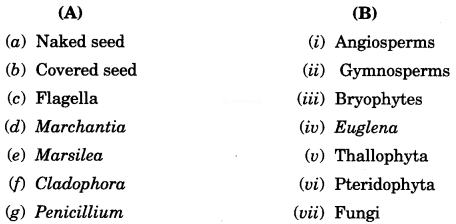
Answer:
(a) (ii)
(b) (i)
(c) (iv)
(d) (iii)
(e) (vi)
(f) (u)
(g) (vii)
Question 30.
Match items of column (A) with items of column (B).
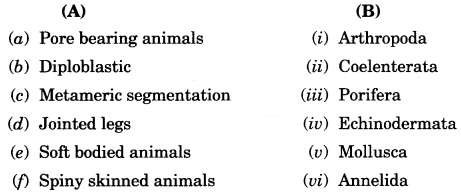
Answer:
(a) (iii)
(b) (ii)
(c) (vi)
(d) (i)
(e) (v)
(f) (iv)
Question 31.
Classify the following organisms based on the absence/presence of true coelom (i.e., acoelomate, pseudocoelomate and coelomate) Spongilla, Sea anemone, Planaria, Liver fluke, Wuchereria, Ascaris, Nereis, Earthworm, Scorpion, Birds, Fishes, Horse.
Answer:
- Spongilla: Acoelomate
- Sea anemone: Acoelomate
- Planaria: Acoelomate
- Liver fluke: Acoelomate
- Wuchereria: Pseudocoelomate
- Ascaris: Pseudocoelomate
- Nereis: Coelomate
- Scorpion: Coelomate
- Earthworm: Coelomate
- Birds, Fishes and Horse: Coelomate
Question 32.
Endoskeleton of fishes are made up of cartilage and bone; classify the following fishes as cartilagenous or bony:
Torpedo, Sting ray, Dog fish, Rohu, Angler fish, Exocoetus.
Answer:
- Torpedo: cartilagenous
- Sting ray: cartilagenous
- Dog fish: cartilagenous
- Rohu: bony
- Angler fish: cartilagenous
- Exocoetus: bony
Question 33.
Classify the following based on number of chambers in their heart.
Rohu, Scoliodon, Frog, Salamander, Flying lizard, King Cobra, Crocodile, Ostrich, Pigeon, Bat, Whale
Answer:
- Rohu, Scoliodon: 2 chambered,
- Frog, Salamander, Flying lizard, King Cobra: 3 chambered,
- Crocodile, Ostrich, Pigeon, Bat, Whale: 4 chambered
Question 34.
Classify Rohu, Scolidon, Flying lizard, King Cobra, Frog, Salamander, Ostrich, Pigeon, Bat, Crocodile and Whale into the cold-blooded/warm-blooded animals.
Answer:
- Cold-blooded: Rohu, Scolidon, Flying lizard, King Cobra, Frog, Salamander Crocodile
- Warm-blooded: Ostrich, Pigeon, Bat, Whale
Question 35.
Name two egg laying mammals.
Answer:
- Platypus
- Echidna.
Question 36.
Fill in the blanks:
(а) Five kingdom classification of living organisms is given by _______
(b) Basic smallest unit of classification is _______
(c) Prokaryotes are grouped in Kingdom _______
(d) Paramecium is a Protista because it is an _______
(e) Fungi do not contain _______
(f) A fungus _______ can be seen without microscope.
(g) Common fungi used in preparing bread is _______
(h) Algae and fungi form symbiotic association called _______
Answer:
(a) Robert Whittaker
(b) species
(c) Monera
(d) eukaryotic unicellular organism
(e) chlorophyll
(f) mushrooms
(g) yeast
(h) lichens
Question 37.
Give True (T) and False (F).
(а) Gymnosperms differ from Angiosperms in having covered seed.
(b) Non flowering plants are called Cryptogamae.
(c) Bryophytes have conducting tissue.
(d) Funaria is a moss.
(e) Compound leaves are found in many ferns.
(f) Seeds contain embryo.
Answer:
(a) False
(b) True
(c) False
(d) True
(e) True
(f) True
Question 38.
Give examples for the following.
(a) Bilateral, dorsiventral symmetry is found in _______
(b) Worms causing the disease elephantiasis is _______
(c) Open circulatory system is found in _______ where coelomic cavity is filled with blood.
(d) _______ are known to have pseudocoelom.
Answer:
(a) Liver Fluke
(b) Filarial worms
(c) Arthropods
(d) Nematodes
Question 39.
Label a, b, c and d, given in the figure below. Give the function of (b).
Answer:
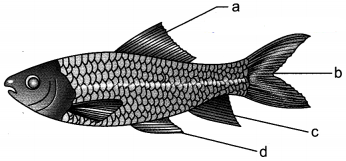
(a) Dorsal fin
(b) Caudal fin
(c) Pelvic fin
(d) Pectoral fin
Function of Caudal fins: Caudal fins help in streamlined movement in water.
Question 40.
Fill in the boxes given in figure with appropriate characteristics/plant groups.
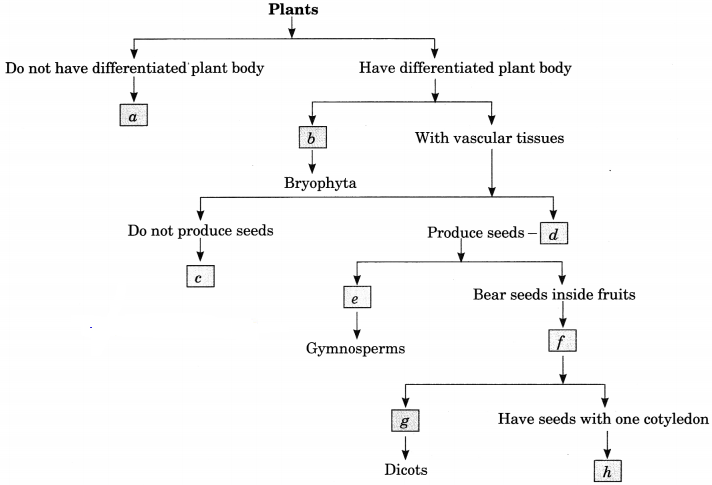
(a) Thallophyta
(b) Without specialized vascular tissue
(c) Pteridophyta
(d) Phanerogams
(e) Bear naked seeds
(f) Angiosperm
(g) Have seeds Thallophyta with two cotyledons
(h) Monocots
Diversity in Living Organisms Class 9 Extra Questions Long Answer Type
Question 1.
Explain the various categories of taxonomical hierarchy.
Answer:
The categories in taxonomical hierarchy are
- Kingdom: The highest category of classification
- Phylum (for animals) / Division (for plants): Group of related classes
- Class: Group of related orders.
- Order: Group of related families.
- Family: Group of related genus.
- Genus: Group of related species.
- Species: Group of organisms which can interbreed among themselves to produce a fertile offspring.
Question 2.
(a) Draw labelled diagrams of three protozoa.
(b) Euglena is a dual organism. Why?
Answer:
(a)
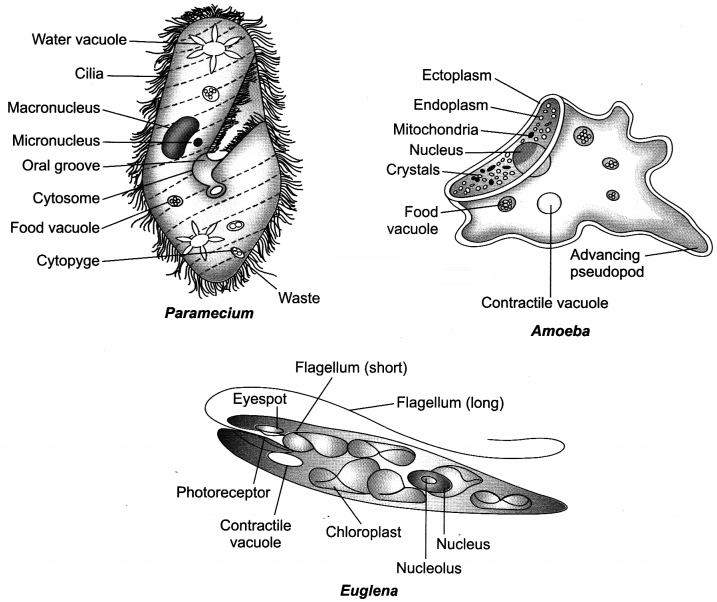
(b) Euglena is a dual organism as:
- It does not have a cell wall and behaves as a heterotrophic organism in the absence of sunlight.
- It contains chloroplast and can perform photosynthesis and behaves as autotroph in the presence of sunlight.
Question 3.
Mention the class to which they belong and give one characteristic feature of each. Frog, fish, lizard, pigeon, bat.
Answer:
(i) Fish: Class Pisces; Aquatic, respiration with gills, moist scales present on the body, two-chambered heart, cold-blooded
(ii) Frog: Class Amphibia; Can live both on land and in water, cold-blooded, three-chambered heart, slimy to touch
(iii) Lizard: Class Reptilia; Cold-blooded, three-chambered heart, hard covering present on eggs to prevent from desiccation
(iv) Pigeon: Class Aves; Forelimbs modified into wings for flight and have feathers, have beak, warm-blooded, four-chambered heart
(v) Bat: Class Mammalia; has mammary glands, warm-blooded, four-chambered heart.
Question 4.
(i) Draw a neat labelled diagram of Hydra.
(ii) Label mesoglea and gastro-vascular cavity.
(iii) Name the group of animals it belongs to.
(iv) Name one species of this group that lives in colonies.
Answer:
(i) and (ii)-See figure

(iii) Phylum Coelenterata
(iv) Corals live in colonies.
Question 5.
Write one difference for each of the following pairs:
(i) Thallophyta and Bryophyta
(ii) Nematoda and Annelida
(iii) Amphibians and Reptiles
Answer:
(i)
- Thallophyta Bryophyta – Plant body is not well differentiated into root, stem and leaves. It is a thalloid example – Spirogyra.
- Bryophyta – Plant body slightly more differentiated than Thallophyta with root-like, stem-like and leaf-like structures, called as Amphibians of the plant kingdom.
(ii)
- Nematoda – Called as roundworms, bilaterally symmetrical having pseudocoelom, example Ascaris
- Annelida – Have a metamerically segmented body and a true coelom, example Earthworm
(iii) Amphibians
- Can live both in land as well as water.
- Lack scales on body and have slimy skin.
- Lay eggs in water.
- Eggs are devoid of tough covering.
Reptiles:
- Most of them are terrestrial animals.
- Have dry scales on body.
- Lay their eggs mostly on land.
- Eggs have a tough covering to protect from drying.
Question 6.
(a) In which two ways are amphibians different from fishes?
(b) Identify the phylum of organisms having the characteristics:
(i) Pore bearing animals and radial symmetry
(ii) Body spiny and radial symmetry
(c) Why do gymnosperms not require water for fertilisation?
Answer:
(a) Amphibians can live both on land as well as water, have three-chambered heart and have lungs for respiration in adult stage.
Fishes are aquatic, have two-chambered heart and have gills for respiration.
(b) (i) Phylum Porifera
(ii) Phylum Echinodermata
(c) Gymnosperms do not require water for fertilisation as they bear pollen grains which are carried away by agents like wind to cause pollination.
Question 7.
Give four features of phylum Coelenterata. Give two examples.
Answer:
The four distinguishing features of phylum Coelenterata are:
- They have a radially symmetrical body.
- The body is made of two layers of cells, so called diploblastic.
- Has tentacles which surround their mouth. Tentacles bear cnidoblasts, stinging cells.
- They have a characteristic cavity called as coelenteron.
- They are solitary like Hydra and can be colonial like Obelia. example Hydra, Obelia, Jelly fish.
Question 8.
List the convention that is followed while writing the scientific names. Give scientific name of Mango and Tiger.
Answer:
The conventions followed while writing the scientific names are:
- The name of the genus begins with a capital letter.
- The name of the species begins with a small letter.
- When printed, the scientific name is given in italics.
- When written by hand, the genus name and the species name have to be underlined separately.
Scientific name of Mango is Mangifera indica and of Tiger is Panthera tigris.
Question 9.
Enlist the features of organisms placed in Protista. Give two examples.
Answer:
The members of the kingdom Protista have the following features:
- All of them are unicellular and eukaryotic.
- Their mode of nutrition is either autotrophic or heterotrophic.
- They are usually aquatic but some of them are parasitic.
- Have cilia, flagella or pseudopodia for movement. example Amoeba, Plasmodium
Question 10.
Give the general characteristics of fungi. Give two examples.
Answer:
The general characteristics of fungi are:
- They are heterotrophic organisms which can occur as saprophytes, parasites or symbionts.
- Their cell wall is made up of chitin and lack chlorophyll.
- Food is stored in the form of glycogen in them instead of starch as stored in plants.
- They are eukaryotes as they have membrane bound nucleus.
- For example: Yeast, Rhizopus, Agaricus, Penicillium, etc.
Question 11.
What are the five kingdoms of Whittaker? Give the most important characteristic feature of each kingdom.
Answer:
The five kingdoms proposed by R. H. Whittaker comprises of – Monera, Protista, Fungi, Plantae and Animalia.
- Kingdom Monera: Unicellular, prokaryotes
- Kingdom Protista: Unicellular eukaryotes
- Kingdom Fungi: Non-photosynthetic, chlorophyll absent, heterotrophic nutrition
- Kingdom Plantae: Chlorophyll bearing, photosynthetic autotrophs
- Kingdom Animalia: Heterotrophic nutrition, cell wall absent
Question 12.
(a) To which group do algae belong? Write one characteristic of the division. Give two examples.
(b) Name the group:
(i) Which includes unicellular eukaryotic organisms
(ii) In which mode of nutrition is saprophytic.
(iii) In which seeds are not enclosed in fruits.
(c) Classify flowering plants on the basis of number of cotyledons present in the seed.
Answer:
(a) Algae are members of division Thallophyta. Characteristic – Aquatic, chlorophyll bearing autotrophs.
(b) (i) Protista
(ii) Fungi
(iii) Gymnosperms
(c) The flowering plants are classified as monocots and dicots on the basis of presence of one cotyledon or two cotyledon respectively.
Question 13.
List three groups of plants and tell which plants are referred to as vascular plants? Also mention out of these which group is further classified on the basis of number of cotyledon? State its two characteristics.
Answer:
The pteridophytes, gymnosperms and angiosperms are the vascular plants. Out of these three, angiosperms are classified on the basis of number of cotyledon as – monocots having one cotyledon and dicots having two cotyledons.
Characteristic features of angiosperms are:
- Their seeds are enclosed within fruit.
- Embryo bears the cotyledons also called seed leaves which provide nutrition to the young plant/seedling on the germination of the seed.
Question 14.
(a) On what basis does the embryo of cryptogam differ from that of phanerogams?
(b) Describe the feature that divides the angiosperms into two groups.
(c) State the two sub-groups of angiosperms.
Answer:
(a) Cryptogams bear naked embryos whereas the phanerogams have embryos which are enclosed in seed.
(b) The feature that divides the angiosperms into two groups is the number of cotyledons present in their embryo.
(c) The two sub-groups of angiosperms are monocots (bear single cotyledon) and dicots (have two cotyledons).
Question 15.
Draw a neat diagram of Spirogyra and label the following parts:
(a) Outermost layer of the cell
(b) Organelle that performs the function of photosynthesis
(c) Jelly-like substance in the cell where all organelles are suspended.
(d) Dark coloured and dot-like structure generally present in the centre of the cell.
Answer:
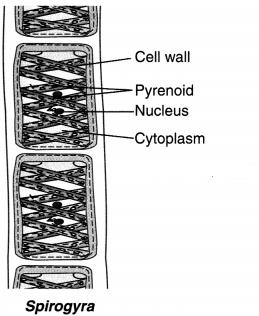
(а) Outermost layer of the cell – Cell wall
(b) Organelle that performs the function of photosynthesis – Chloroplast
(c) Jelly-like substance in the cell where all organelles are suspended – Cytoplasm
(d) Dark coloured and dot-like structure generally present in the centre of the cell – Nucleus
Question 16.
Thallophyta, bryophyta and pteridophyta are called as ‘Cryptogams’. Gymnosperms and Angiosperms are called as ‘phanerogams’. Discuss why. Draw one example of Gymnosperm.
Answer:
Thallophyta, bryophyta and pteridophyta are called as ‘Cryptogams’ because they have hidden or inconspicuous reproductive organs. Spores are formed in them instead of seeds. Gymnosperms and Angiosperms are called as ‘phanerogams’ as they have well differentiated reproductive tissue/organs. Seed harbours the embryo and provides it nourishment too.

Question 17.
Define the terms and give one example of each
(a) Bilateral symmetry
(b) Coelom
(c) Triploblastic
Answer:
(a) If the organism can be divided exactly into two halves from one median plane only, the symmetry is called bilateral symmetry, example liver fluke.
(b) The internal body cavity present between visceral organs and body wall in which well developed organs can be accommodated is called as coelom, example butterfly.
(c) The organisms who have three embryonic layers are called as triploblastic organisms example star fish.
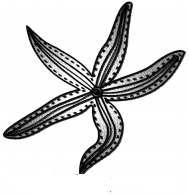
Question 18.
You are given leech, Nereis, Scolopendra, prawn and scorpion; and all have segmented body organisation. Will you classify them in one group? If no, give the important characters based on which you will separate these organisms into different groups.
Answer:
No, all the organisms given in the question do not belong to one group.
Leech and Nereis belong to phylum Annelida because they have metamerically segmented body i.e., body is divided into many segments internally by septa. Body segments are lined up one after the other from head to tail.
The characteristic identifying feature of Scolopendra, prawn and scorpion are the jointed legs and open circulating system due to which they are placed in phylum Arthropoda.
Question 19.
Which organism is more complex and evolved among Bacteria, Mushroom and Mango tree? Give reasons.
Answer:
Mango tree is more complex and evolved because, it is eukaryotic, autotrophic, terrestrial sporophyte with covered seed. Bacteria is unicellular prokaryote and fungi are the heterotrophic, simple thallophyte with no tissue systems.
Question 20.
Differentiate between flying lizard and bird. Draw the diagram.
Answer:
Flying lizard belongs to the group reptiles and is characterised as cold-blooded, body covered with scales and have three-chambered heart, while birds belong to group aves and are characterised as warm¬blooded, having feather covered body, forelimbs modified as wings and having four-chambered heart.
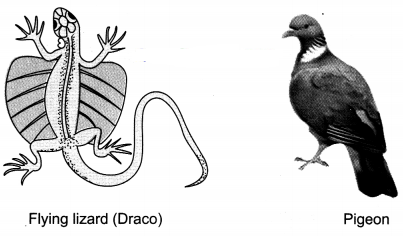
Question 21.
List out some common features in cat, rat and bat.
Answer:
Bat, rat and cat belong to the class Mammalia and have following common features:
(а) All have notochord at some stage of their life cycle.
(b) All are warm-blooded:
(c) All have four-chambered heart.
(d) All have skin covered with hair and with sweat and oil glands.
Question 22.
Why do we keep both snake and turtle in the same class?
Answer:
Because both are –
- Cold-blooded
- Have scales
- Breathe through lungs
- Have three-chambered heart
- They lay eggs with tough covering.
Diversity in Living Organisms Class 9 Extra Questions HOTS
Question 1.
Which group among the Amphibia and Pisces is more advanced and why?
Answer:
The amphibians are more advanced than the Pisces as
- Amphibians can survive both on land as well as in water whereas the members of Pisces can survive only in water.
- Amphibians have a three-chambered heart compared to the two-chambered heart present in the Pisces.
- Amphibians have the ability to respire through lungs but fishes respire through gills.
Question 2.
The protozoans have been included in Protista and not in kingdom Animalia. Give reason.
Answer:
Protozoans are unicellular, eukaryotes so they have been kept in the Kingdom Protista comprising of only the unicellular, eukaryotic organisms. Kingdom Animalia consists of multicellular eukaryotes.
Question 3.
Three types of animal specimen were collected by Rajeev and labelled as A, B and C. The specimen A had slimy skin, respired through lungs, B had dry scales with eggs having tough covering and the specimen C had moist scales with terminal mouth. Identify the class to which the specimens belong.
Answer:
A: Amphibia
B: Reptilia
C: Pisces
Question 4.
While playing near a pond Anmol experienced a pain on his feet. He saw a black coloured organism with metamerically segmented body was clinging to his foot and trying to suck blood from his foot. On the basis of this identify the organism and the phylum to which it may belong to. Name two other members of the phylum to which this organism belongs.
Answer:
- Organism: Leech
- Phylum: Annelida
- Other members: Nereis, Earthworm
Question 5.
Shobha went for a school trip and was shown some organisms which were told by their teachers as the members of the second largest phylum of kingdom Animalia. The organisms had a shell on their body and moved around with their muscular foot. Name the phylum to which the mentioned organism will belong. Give one more characteristic feature and two examples of such organisms.
Answer:
Phylum : Mollusca
Feature : Reduced Coelomic cavity
Examples : Snails and mussels
Question 6.
Three types of plant specimen were observed by Renu and labelled as A, B and C. The specimen A had green colour with undifferentiated thalloid body, B had well differentiated body which formed spores and had a vascular system and the specimen C had cones which had seeds but no fruits were formed in them. Identify the class to which the specimens belong.
Answer:
A: Thallophyta
B: Pteridophyta
C: Gymnosperms
Diversity in Living Organisms Class 9 Extra Questions Value Based (VBQs)
Question 1.
Reena read an article in newspaper regarding the problems caused by the chemical fertilisers. She surfed through the internet and came to know that certain blue-green algae are a good source of fertilisers. She advised the farmers of the area to use them and helped them to stop using chemical fertilisers.
(a) Which group comprises of the blue-green algae?
(b) How do these blue-green algae increase soil fertility?
(c) What are the characteristic features of the group to which they belong?
(d) What values are shown by Reena by her work?
Answer:
(a) Kingdom Monera
(b) They fix atmospheric nitrogen and increase soil fertility
(c) They are unicellular prokaryotes which do not have a well defined nucleus.
(d) Values shown by Reena are concern for environment, helpfulness, eco-friendliness and scientific attitude.
Question 2.
During their trip to a hill station, Shiksha observed some thalloid plants having little differentiation of body which were growing on the moist and damp surface in the form of dense mats. She asked her teacher about them and their role. Her teacher told her which group of organism they were and said that these dense mats were helpful in preventing soil erosion and need water for fertilisation.
(a) What is the probable group of organisms which her teacher would have told her?
(b) What is the peculiar feature of this group of organisms?
(c) Give two examples of members of the group.
(d) What are the values shown by Shiksha?
Answer:
(a) Bryophytes
(b) Can live both on land and in water
(c) Marchantia, Funaria
(d) The values shown by Shiksha are keen observation and scientific attitude.
